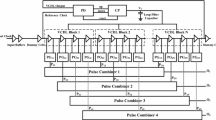Abstract
Feedback envelope tracking amplifier is one technology to realize linear amplification for nonlinear class E power amplifier. In this paper, the basic architecture and frequency response of the feedback envelope tracking amplifier are analyzed in detail. And the analysis shows that the feedback envelope tracking loop can be implemented to satisfy the system’s specifications of linearity and stability, if the bandwidth and the other design parameters are properly selected. The limited bandwidth and different time delay between the envelope path and the phase path can cause intermodulation distortions which deteriorate the linearity of the feedback envelope tracking amplifier, the model for the intermodulation distortions of the feedback envelope tracking class E power amplifier is analyzed compared to the envelope elimination and restoration transmitter. In order to evaluate the broadband performance of the feedback envelope tracking class E power amplifier, the error vector magnitude (EVM) specification is also analyzed, and the simulation results on EVM for WCDMA signal is given.






Similar content being viewed by others
References
Cox, D. C. (1974). Linear amplification with nonlinear components. IEEE Transactions on Communications, 22(12), 1942–1945.
Wang, N., Peng, X., et al. (2005). Linearity of X-band class-E power amplifiers in EER operation. IEEE Transactions on Microwave Theory and Techniques, 53(3), 1096–1102.
Rembold, B., & Koch, O. (2006). CLIER—Combination of LINC and EER method. Electronics Letters, 42(16), 900–901.
Popp, J., & Lie, D. Y. C. (2006). Fully-integrated highly-efficient RF Class E SiGe power amplifier with an envelope-tracking technique for EDGE applications. IEEE Radio and Wireless Symposium, 231–234.
Draxler, P., Lanfranco, S., et al. (2006). High efficiency envelope tracking LDMOS power amplifier for W-CDMA. IEEE MTT-S International Microwave Symposium Digest, 1534–1537.
Wang, F., Kimball, D. F., et al. (2007). A monolithic high-efficiency 2.4-GHz 20-dBm SiGe BiCMOS envelope-tracking OFDM power amplifier. IEEE Journal of Solid-State Circuits, 42(6), 1271–1281.
Raab, F. H. (1996). Intermodulation distortion in Kahn-technique. IEEE Transactions on Microwave Theory and Techniques, 44(12), 2273–2278.
Milosevic, D., Van der Tang, J., et al. (2004). Intermodulation products in the EER technique applied to class-E amplifiers. International Symposium on Circuits and Systems 637–640.
Sowlati, T., Greshishchev, Y. M., et al. (1997). Phase-correcting feedback system for class E power amplifier. IEEE Journal of Solid-State Circuits, 32(4), 544–549.
Marquez-Martinez, L. A., & Moog, C. H. (2004). Input-output feedback linearization of time-delay systems. IEEE Transactions on Automatic Control, 49(5), 781–785.
Wang, N., Yousefzadeh, V., et al. (2004). 60% efficient 10-GHz power amplifier with dynamic drain bias control. IEEE Transactions on Microwave Theory and Techniques, 52(3), 1077–1081.
Sokal, N. O., & Sokal, A. D. (1975). Class E-A new class of high efficiency tuned single-ended switching power amplifiers. IEEE Journal Solid-State Circuits, 10(3), 168–176.
Georgiadis, A. (2004). Gain, phase imbalance, and phase noise effects on error vector magnitude. IEEE Transactions on Vehicular Technology, 53(2), 443–449.
Chu, W.-Y., Bakkaloglu, B., & Kiaei, S. (2008). A 10 MHz bandwidth, 2 mV ripple PA regulator for CDMA transmitters. IEEE Journal of Solid State Circuits, 43(12), 2809–2819.
Author information
Authors and Affiliations
Corresponding author
Rights and permissions
About this article
Cite this article
You, F., He, S., Tang, X. et al. Analysis of the feedback envelope tracking linear class E power amplifier. Analog Integr Circ Sig Process 64, 129–136 (2010). https://doi.org/10.1007/s10470-009-9436-1
Received:
Revised:
Accepted:
Published:
Issue Date:
DOI: https://doi.org/10.1007/s10470-009-9436-1




